--------------
Monday, 27 August 2018
Paul and his 500 unknown witnesses ?
--------------
Saturday, 18 August 2018
As- samiri a individual
“Samiri’s name as generally believed, was Musa Ibn Zafar. Ibn Jarar has narrated from Sayiddina Ibn ‘Abbas {ra} that Samiri was born in the year when under the orders of Pharaoh all male Israili children were to be killed. His mother, fearing the worst, put him in the hallow of a cave and covered its mouth.” – Tafsir Maa’riful Qur’aan, page 144.
Sayiddina Ibn ‘Abbas {ra} says that he belonged to a nation of cow-worshippers who somehow reached Egypt and pretended to join the religion of Bani ‘Israil whereas in actual fact he was a hypocrite. (Qurtubi) – Tafsir Maa’riful Qur’aan, page 143.Where did they come from, if they were not from around Egypt?
“According to Sayddina Sa’id ibn Jubair {ra} he was a Persian from the Kirman province.” – Tafsir Maa’riful Qur’aan, page 143.
Let’s continue by trying to grasp the history of this Samiri, so we can know who he was or from where he came:
“Samiri’s name as generally believed, was Musa Ibn Zafar. Ibn Jarar has narrated from Sayiddina Ibn ‘Abbas {ra} that Samiri was born in the year when under the orders of Pharaoh all male Israili children were to be killed. His mother, fearing the worst, put him in the hallow of a cave and covered its mouth.” – Tafsir Maa’riful Qur’aan, page 144.
Now that we’ve established some form of historical context to this person, his lineage does go back to the time of Moses (Musa alayhi as salaam), so this person did exist at the time of Moses. In that context, why is he called “As Samiri”, well, there are two probablities here:
(1) It could be a place from which he came.
(2) It could be a title due to his beliefs.
Earlier Islamic sources tend to cite both (1) and (2) as their understanding of the person named As-Samiri, that being, he came from a people who were worshipers of the cows:
Sayiddina Ibn ‘Abbas {ra} says that he belonged to a nation of cow-worshippers who somehow reached Egypt and pretended to join the religion of Bani ‘Israil whereas in actual fact he was a hypocrite. (Qurtubi) – Tafsir Maa’riful Qur’aan, page 143.
Where did they come from, if they were not from around Egypt?
“According to Sayddina Sa’id ibn Jubair {ra} he was a Persian from the Kirman province.” – Tafsir Maa’riful Qur’aan, page 143.
Now this logically makes sense.
(1) The Samiri was born during the time of Moses.
(2) The Samiri was from Persian (Mesopotamia) and was brought to or near Egypt when a group of Persians migrated.
(3) Persia is near the Indus Valley River Civilization (known cow worshipers), in fact, they share similar cultural traits (languages, religions, dress).
Therefore it is logical to assume that the Samiri is a person who was from among a people who worshiped cows, and who had migrated to near Egypt. The entire narration from the Qur’aan makes sense when compared to basic history. Of course one had to be objective and look outside the inconsistent and incoherent Biblical tradition and really accept the historical narrative as it exists through modern historical interpretations.
The historical context is easy to grasp, the Samiri was a cow worshiper with Mesopotamian origins (from which his religion came) through the Indian peoples (Indus Valley Civilization – known cow worshipers):
In the case of Egyptian and Harappan civilizations, there exists considerable evidence that the two societies, which flanked Mesopotamia on the west and east, respectively, had continuous trade contact with the cities of Sumer and, in the case of Egypt, political and military contacts as well. So the channels for the diffusion of technology and ideas certainly were there. It should probably be stressed at this point that a certain amount of diffusion and cross-fertilization is critical to the development of any civilization and no society has developed in total isolation. Whatever the degree of borrowing, however, every civilization adapts and applies ideas, technologies and institutions to its own physical environment and cultural heritage. – (The World’s History (Volumes 1 and 2 – 2nd Edition), Chapter 3 (River Valley Civilizations), Page 11 – by Howard Spodek.)
Therefore in conclusion, the Biblical claim is that a city known as Samaria did not exist until some 700 years after Moses, therefore the Samiri people could not have existed. Whereas historical knowledge (go figure, the Bible contradicts history) indicates that the Mesopotamian, Harappan (Indus Valley Civilization) and the Egyptians all shared a common and integrated history some 1500 years before Moses (Civlizations from 3000 BCE, Moses from 1500 BCE) and the incident of Pharaoh.
Refuting KAHBA / MECCAH didnt exist before 400AD.
What prompted me to write this short essay was there are circulating lies concocted by Liar Christians such as Dr Amari Rafat that KAHBA/MECCAH didnt exist before 400AD! This liar even added more lies to his lies that there is no single scholars who recorded that KAHBA existed before 400AD!
This lie was maliciously espoused by some low level internet troll who ignorantly added that Prophet Abraham therefore didnt built the Kahba! How true is that? Well this is simply UNTRUE! Scholars have recorded the existence of Kahba / Mecca even before the Christianity came into existence.
1. Diodorus Siculus was a Greek historian,
https://archive.org/stream/religiousceremon00good#page/124/mode/2up“Among the variety of fabulous traditions which have been propagated by the followers of Mahomet, concerning the origin of this building, we find it asserted, that its existence is coeval with our parents, and that it was built by Adam, after his expulsion from paradise, from a representation of the celestial temple, which the almighty let down from heaven in curtains of light and placed in Mecca, perpendicular under the original. To this the patriarch was commanded to turn his face when he prayed, and to compass it by way of devotion, as the angels did the heavenly one. After the destruction of this temple by the deluge, it was rebuilt by Abraham and his son Ishmael on the same spot, and after the same model, according to directions, which they received by revelation; and since that time, it has continued to be the object of veneration to Ishmael’s descendants. Whatever discredit we may give to these, and other ravings of the Moslem imposter concerning the Caaba its high antiquity cannot be disputed; and the most probable account is, that it was built and used for religious purposes by some of the early patriarchs; and after the introduction of idols, it came to be appropriated to the reception of the pagan divinities. Diodorus Siculus, in his description of the cost of the Red Sea, mentions this temple as being, in his time, held in great veneration by all Arabians; and Pocoke informs us, that the linen or silken veil, with which it is covered, was first offered by a pious King of the Hamyarites, seven hundred years before the time of Mahomet.”
””And a temple has been set up there, which is very holy and exceedingly revered by all Arabians” ,this mention comes around 30 -50 BC (Before Christ) Almost 2000 years ago Greek historians mention Mecca or say Makkah as it is orginally pronounced .

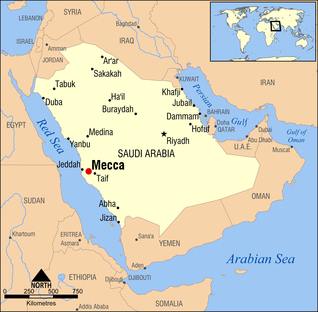
2. Ptolemy’s
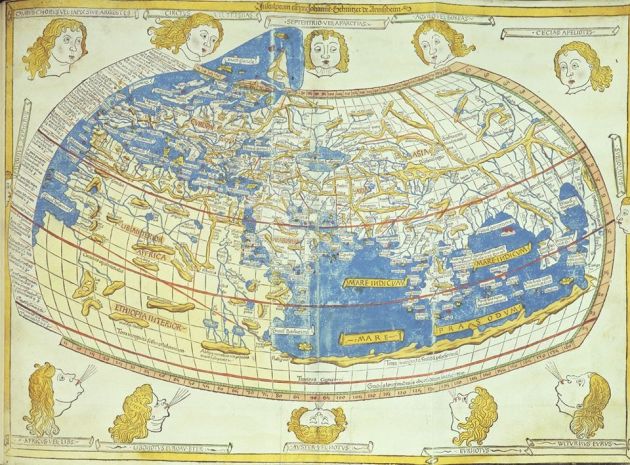
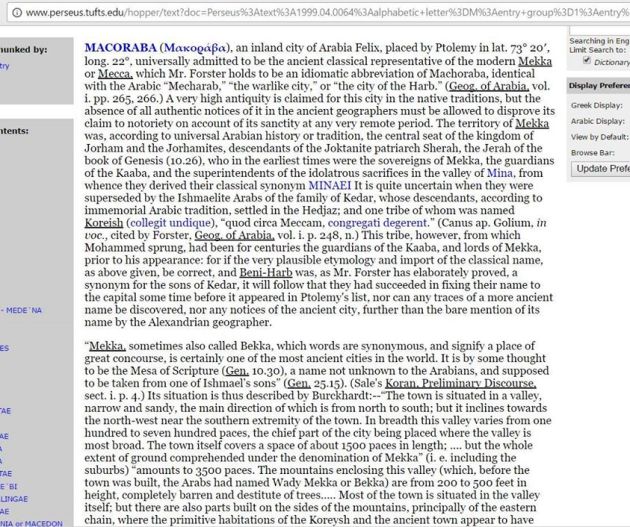
MACORABA (Μακοράβα), an inland city of Arabia Felix, placed by Ptolemy in lat. 73° 20′, long. 22°, universally admitted to be the ancient classical representative of the modern Mekka or Mecca, which Mr. Forster holds to be an idiomatic abbreviation of Machoraba, identical with the Arabic “Mecharab,” “the warlike city,” or “the city of the Harb.” (Geog. of Arabia, vol. i. pp. 265, 266.) A very high antiquity is claimed for this city in the native traditions, but the absence of all authentic notices of it in the ancient geographers must be allowed to disprove its claim to notoriety on account of its sanctity at any very remote period. The territory of Mekka was, according to universal Arabian history or tradition, the central seat of the kingdom of Jorham and the Jorhamites, descendants of the Joktanite patriarch Sherah, the Jerah of the book of Genesis (10.26), who in the earliest times were the sovereigns of Mekka, the guardians of the Kaaba, and the superintendents of the idolatrous sacrifices in the valley of Mina, from whence they derived their classical synonym MINAEI It is quite uncertain when they were superseded by the Ishmaelite Arabs of the family of Kedar, whose descendants, according to immemorial Arabic tradition, settled in the Hedjaz; and one tribe of whom was named Koreish (collegitundique), “quod circa Meccam, congregatidegerent.” (Canus ap. Golium, in voc., cited by Forster, Geog. of Arabia, vol. i. p. 248, n.) This tribe, however, from which Mohammed sprung, had been for centuries the guardians of the Kaaba, and lords of Mekka, prior to his appearance: for if the very plausible etymology and import of the classical name, as above given, be correct, and Beni-Harb was, as Mr. Forster has elaborately proved, a synonym for the sons of Kedar, it will follow that they had succeeded in fixing their name to the capital some time before it appeared in Ptolemy’s list, nor can any traces of a more ancient name be discovered, nor any notices of the ancient city, further than the bare mention of its name by the Alexandrian geographer.“Mekka, sometimes also called Bekka, which words are synonymous, and signify a place of great concourse, is certainly one of the most ancient cities in the world. It is by some thought to be the Mesa of Scripture (Gen. 10.30), a name not unknown to the Arabians, and supposed to be taken from one of Ishmael’s sons” (Gen. 25.15). (Sale’s Koran, Preliminary Discourse, sect. i. p. 4.) Its situation is thus described by Burckhardt:–“The town is situated in a valley, narrow and sandy, the main direction of which is from north to south; but it inclines towards the north-west near the southern extremity of the town. In breadth this valley varies from one hundred to seven hundred paces, the chief part of the city being placed where the valley is most broad. The town itself covers a space of about 1500 paces in length; …. but the whole extent of ground comprehended under the denomination of Mekka” (i. e. including the suburbs) “amounts to 3500 paces. The mountains enclosing this valley (which, before the town was built, the Arabs had named Wady Mekka or Bekka) are from 200 to 500 feet in height, completely barren and destitute of trees….. Most of the town is situated in the valley itself; but there are also parts built on the sides of the mountains, principally of the eastern chain, where the primitive habitations of the Koreysh and the ancient town appear to have been placed.” It is described as a handsome town; with streets broader, and stone houses more lofty, than in other Eastern cities: but since the decline of the pilgrimage “numerous buildings in the outskirts have fallen completely into ruin, and the town itself exhibits in every street houses rapidly decaying.” Its population has declined in proportion. The results of Burckhardt’s inquiries gave “between 25,000 and 30,000 stationary inhabitants for the population of the city and suburbs, besides from 3000 to 4000 Abyssinians and black slaves: its habitations are capable of containing three times this number.” This estimate, however, shows a considerable increase within the last three centuries; for “in the time of Sultan Selym I. (in A. H. 923, i. e. A.D. 1517) a [p. 2.240]census was taken, and the number found to be 12,000 men, women, and children.” In earlier times the population was much more considerable; for “when Abou Dhaker sacked Mekka in A. H. 314 (A.D. 926) 30,000 of the inhabitants were killed by his ferocious soldiers.” Ali Bey’s estimate in A.D. 1807 is much lower than Burckhardt’s in A.D. 1814. Yet the former says “that the population of Mekka diminishes sensibly. This city, which is known to have contained more than 100,000 souls, does not at present shelter more than from 16,000 to 18,000;” and conjectures that “it will be reduced, in the course of a century, to the tenth part of the size it now is.” The celebrated Kaaba demands a cursory notice. It is situated in the midst of a great court, which forms a parallelogram of about 536 feet by 356, surrounded by a double piazza. This sanctuary, called, like that of Jerusalem, El-Haram, is situated near the middle of the city, which is built in a narrow valley, having a considerable slope from north to south. In order to form a level area for the great court of the temple, the ground has evidently been hollowed out, subsequently to the erection of the Kaaba, which is the only ancient edifice in the temple. The building itself (called by the natives Beit-Ullah, the House of God), probably the most ancient sacred building now existing, is a quadrilateral tower, the sides and angles of which are unequal. Its dimensions are 38 feet by 29, and its height 34 feet 4 inches; built of squarehewn but unpolished blocks of quartz, schorl, and mica, brought from the neighbouring mountains. The black stone, the most sacred object of veneration, is built into the angle formed by the NE. and SE. sides, 42 inches above the pavement. It is believed by the Moslems to have been presented to Abraham by the angel Gabriel, and is called “the heavenly stone.” Ali Bey says that “it is a fragment of volcanic basalt, sprinkled throughout its circumference with small, pointed, coloured crystals, and varied with red feldspath upon a dark black ground like coal.” The famous well of Zemzem, in the great mosk, is 56 feet deep to the surface of the water, fed by a copious spring; but its water, says Burckhardt, “however holy, is heavy to the taste, and impedes digestion.” Ali Bey, on the contrary, says that “it is wholesome, though warmer than the air even in that hot climate. The town is further supplied with rain-water preserved in cisterns: but the best water in Mekka is brought by a conduit from the vicinity of Arafat, six or seven hours distant.” (Ali Bey, Travels, vol. ii. pp. 74–114; Burckhardt, Travels in Arabia, pp. 94, &c.)
3. Meccah on Samaritan Book of the Secret of Moses
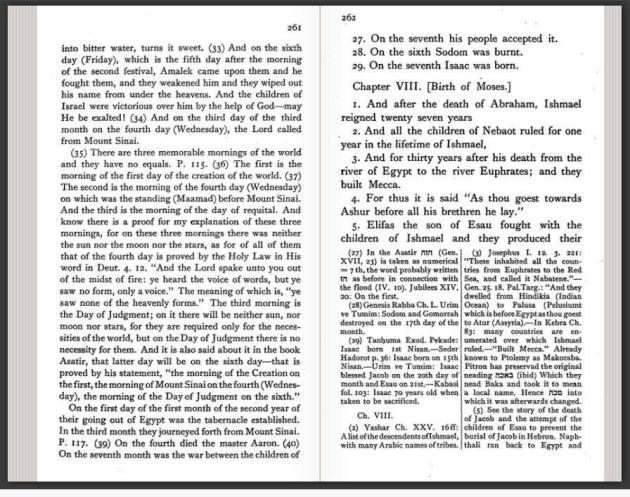
4. Meccah and Medina On The Bible – Genesis 10:30

“And their dwelling was from Mecca towards al-Medina, unto the mountain of the East.” [Œuvres complètes de R. Saadia ben Iosef al-Fayyoûmî, ed. by J. Darenbourg, vol. 1 (Paris: E. Leroux, 1893), p. 17.]
“were it not for Saadia, the Torah would almost have disappeared from the midst of Israel; for it was he who made manifest what was obscure therein, made strong what had been weakened, and made it known far and wide by word of mouth and in writing.” [H. Malter, Saadia Gaon: His Life and Works, (Philadelphia: The Jewish Publication Society of America, 1921), p. 279.]
The situation of Mesha is uncertain. But it is obviously the western boundary of the settlement, and may have been in the neighborhood of Mecca and Medina. Sephar is perhaps the Arabic Zaphari, called by the natives Isfor, a town on the south coast near Mirbat. It seems, however, to be, in the present passage, the “mount of the east” itself, a thuriferous range of hills, adjacent, it may be, to the seaport so-called. Gesenius and others fix upon Mesene, an island at the head of the Persian Gulf, as the Mesha of the text. But this island may have had no existence at the time of the Joctanite settlement. These boundaries include the greater part of the west and south coast of the peninsula, and are therefore sufficient to embrace the provinces of Hejaz (in part), Yemen, and Hadramaut, and afford space for the settlements of the thirteen sons of Joctan. The limits thus marked out determine that all these settlers, Ophir among the rest, were at first to be found in Arabia, how far soever they may have wandered from it afterward.
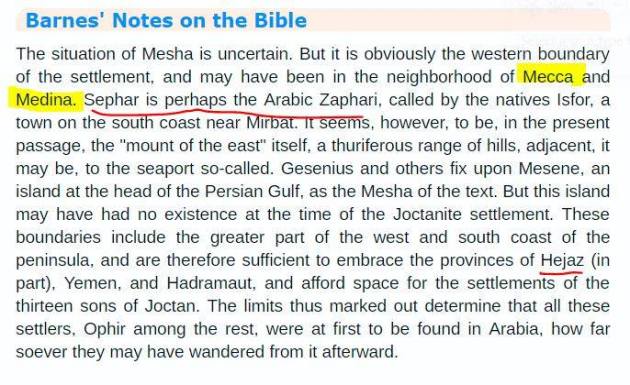
And their dwelling was from Mesha, as thou goest unto Zephar, a mount of the east. Mesha, which is thought to be the Muza of Ptolemy and Pliny, was a famous port in the Red sea, frequented by the merchants of Egypt and Ethiopia, from which the Sappharites lay directly eastward; to whose country they used to go for myrrh and frankincense, and the like, of which Saphar was the metropolis, and which was at the foot of Climax, a range of mountains, which perhaps might be formerly called Saphar, from the city at the bottom of it, the same with Zephar here: by inspecting Ptolemy’s tables (o), the way from one to the other is easily discerned, where you first meet with Muza, a port in the Red sea, then Ocelis, then the mart Arabia, then Cane, and so on to Sapphar or Sapphara; and so Pliny says (p), there is a third port which is called Muza, which the navigation to India does not put into, only the merchants of frankincense and Arabian odours: the towns in the inland are the royal seat Saphar; and another called Sabe; now the sons of Joktan had their habitations all from this part in the west unto Zephar or Saphar eastward, and those were reckoned the genuine Arabs: Hillerus (q) gives a different account of the situation of the children of Joktan, as he thinks, agreeably to these words of Moses; understanding by Kedem, rendered the east, the mountains of Kedem, or the Kedemites, which sprung from Kedem or Kedomah, the youngest son of Ishmael, Genesis 25:15 and Zephar, the seat of the Sepharites, as between Mesha and Kedem; for, says he, Mesha is not Muza, a mart of the Red sea, but Moscha, a famous port of the Indian sea, of which Arrian and Ptolemy make mention; and from hence the dwelling of the Joktanites was extended, in the way you go through the Sepharites to the mountainous places of Kedem or Cadmus: perhaps nearer the truth may be the Arabic paraphrase of Saadiah (r), which is“from Mecca till you come to the city of the eastern mountain, or (as in a manuscript) to the eastern city,”meaning perhaps Medina, situate to the east; so that the sense is, according to this paraphrase, that the sons of Joktan had their dwelling from Mecca to Medina; and so R. Zacuth (s) says, Mesha in the Arabic tongue is called Mecca; and it is a point agreed upon by the Arabs that Mesha was one of the most ancient names of Mecca; they believe that all the mountainous part of the region producing frankincense went in the earliest times by the name of Sephar; from whence Golius concludes this tract to be the Mount Zephar of Moses, a strong presumption of the truth of which is that Dhafar, the same with the modern Arabs as the ancient Saphar, is the name of a town in Shihr, the only province in Arabia bearing frankincense on the coast of the Indian ocean (t).(o) Geograph. l. 6. c. 7. (p) Nat. Hist. l. 6. c. 23. (q) Onomastic. Sacr. p. 116. (r) In Pocock. Specimen Hist. Arab. p. 34. (s) In Juchasin, fol. 135. 2.((t) Universal History, vol. 18. p. 353.
5. Meccah, Pilgrimage in The Bible Exodus 5.1
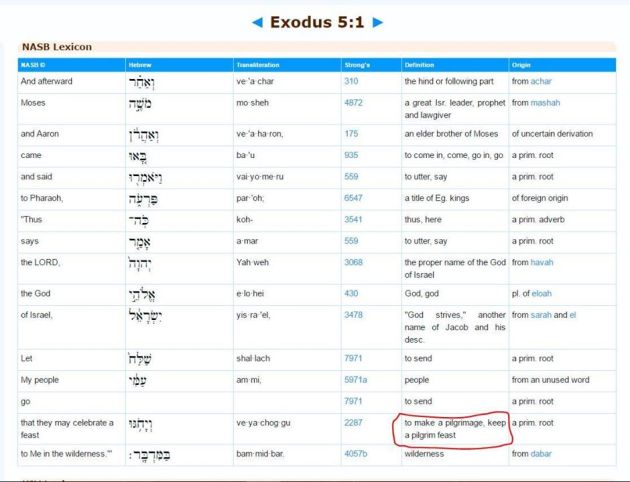
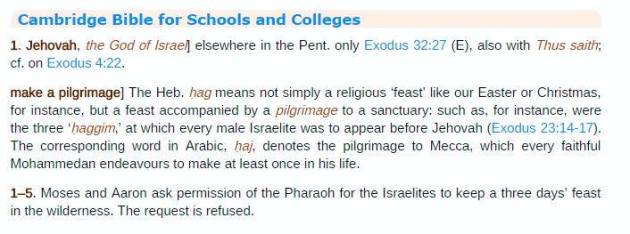
make a pilgrimage] The Heb. ḥag means not simply a religious ‘feast’ like our Easter or Christmas, for instance, but a feast accompanied by a pilgrimage to a sanctuary: such as, for instance, were the three ‘ḥaggim,’ at which every male Israelite was to appear before Jehovah (Exodus 23:14-17). The corresponding word in Arabic, ḥaj, denotes the pilgrimage to Mecca, which every faithful Mohammedan endeavours to make at least once in his life.
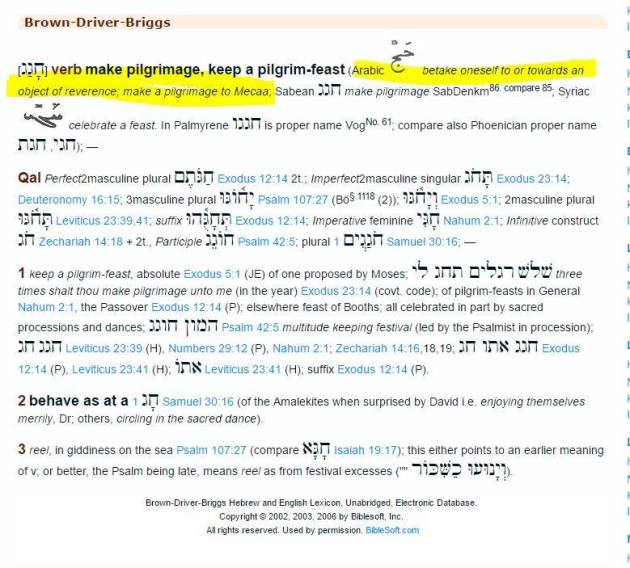
6. Mecca did exist before the advent of Christianity -Secular historical evidence

7. Return to Meccah Book By Judeo Christian Rabbi Avi Lipkin
Additional reading materials and refutation : https://www.bismikaallahuma.org/his…
The true God whom Christians are avoiding.
We know also that the Son of God has come and has given us understanding, so that we may know him who is true. And we are in him who is true...
-
Related post from before: https://islamicarchives.wordpress.com/2016/09/05/what-is-the-minimum-age-of-marriage-according-to-jewish-law/ ...
-
Another Christian Failure Did Ibn Mas'ud (RA) have 111 Surah and Variances like these nasara claim? How about Ubayy ibn Ka'b d...









